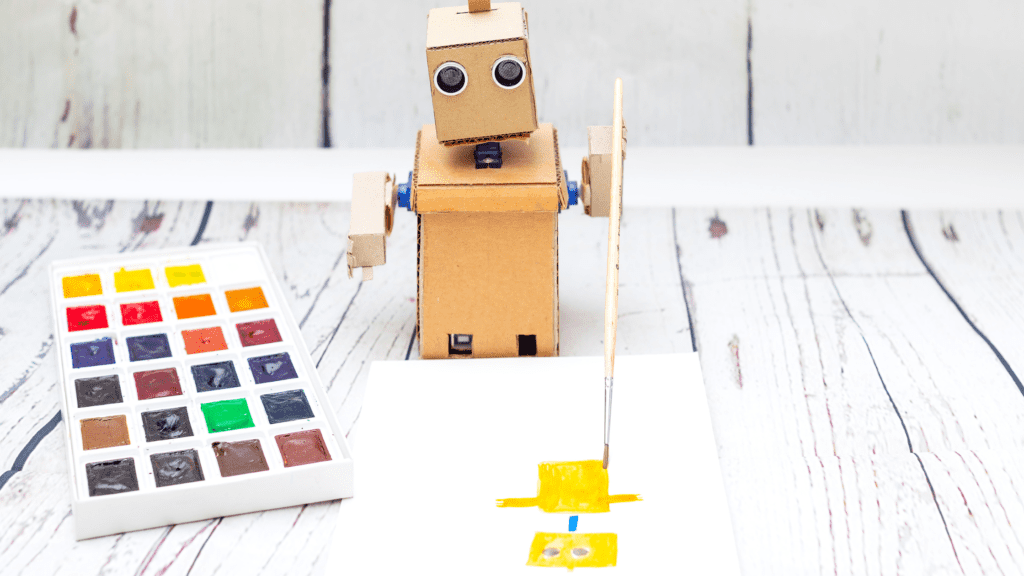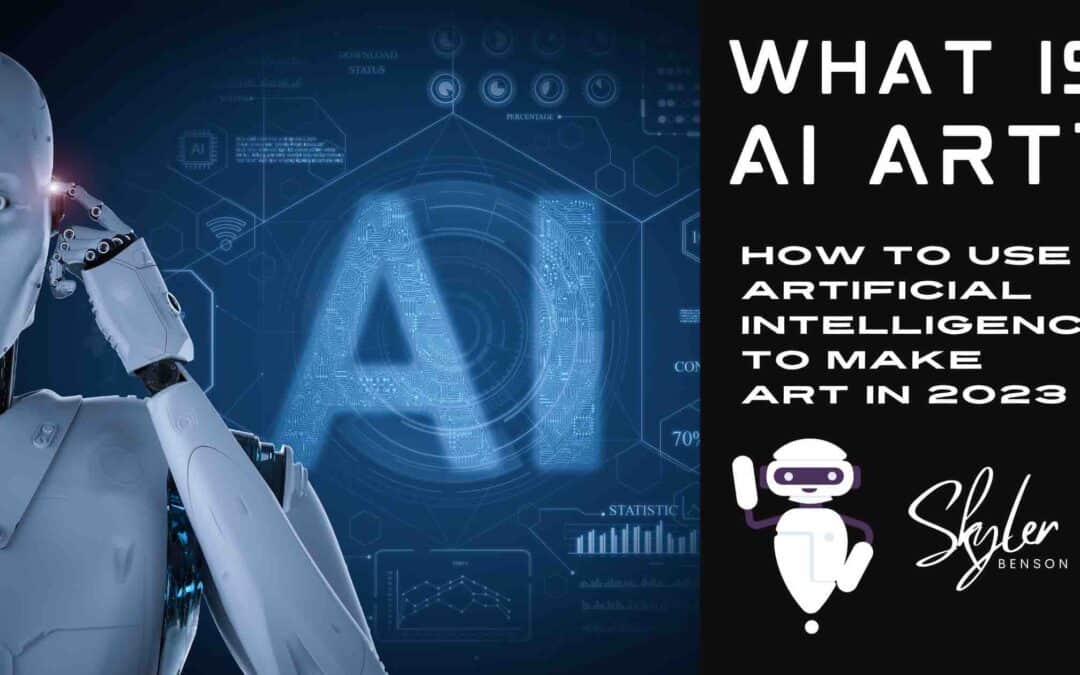AI Art is generating massive hype, with pieces selling for hundreds of thousands of dollars, but have you found yourself asking what is AI art?
Are you an artist, creative, or tech enthusiast looking to explore the fascinating world of Ai-generated artwork? Or maybe you’re just an art appreciator. It’s no surprise that more and more people are turning to digital tools to create works of art.
AI art—also known as artificial intelligence art—is created by artists with the aid of computer algorithms and machine learning.
Artificial Intelligence has broken down barriers between what was once possible and what can be achieved today.
From 3D-rendered images to stunning glimpses of generative abstractions – we’ll explore how computers and algorithms can be transformed into expressions that are as magical as any traditional artwork.
With advances in Artificial Intelligence technology, there is no longer a barrier to entry for aspiring artists. As a result, it has become easier than ever for anyone to become an artist with AI art generators.
There is no question that AI is changing the art world almost overnight.
Are you ready to be part of a creative revolution?
Let’s get started.
What Is AI Art?
AI art (also known as artificial intelligence art) is a form of artwork created with the assistance of computer algorithms and machine learning. AI art utilizes natural language processing, image recognition technology, and other advancements in Artificial Intelligence.
The machine learning algorithm uses a data set of images to train itself and produce an AI-generated image. The data set can be as simple as a few shapes or colors to create abstract artwork. Or it can be complex photos of people or animals.
The ai art generator will then analyze the data and create its own unique version of the dataset – adding its own spin. This is how AI artworks are created.
The finished ai-generated artist’s work depends on their vision and the inputs and text instructions they provide – it can range from photorealistic to abstract or baroque.
How Does AI Art Work?
To understand what AI Art can do, it’s essential to first know the basics about how it works. AI art works using computer algorithms, machine learning, natural language processing, image recognition technology, and other Artificial Intelligence advancements to create digital pieces of artwork.
Human artists use AI system art generators to provide text input and instructions, which are used to generate AI artwork based on their vision.
By manipulating data sets created by machine learning algorithms, artists can expand their creative processes beyond what was once thought possible. They can also draw inspiration from traditional artwork and photographs to create new pieces that exhibit a unique blend of both styles. You can even select the artist you wish to take inspiration from.
A computer is “trained” on data to create visually appealing works of art. This training can involve feeding the algorithm with a large set of images. Then it learns what characteristics make up a particular type of artwork and uses that knowledge to generate new pieces.

Types Of Machine Learning Algorithms
Different types of machine learning algorithms are used in AI art. They include:
1. Generative Adversarial Networks (GAN)
Generative Adversarial Networks (GAN) are a type of algorithm used in Artificial Intelligence to create digital works of art.
GANs work by having two different parts, a generator, and a discriminator. The generator creates something, and then the discriminator looks at it and sees if it is real or not.
The generator will also improve itself each time the discriminator gives it feedback. This means you can take a GAN and feed it images of artwork or photographs. It then learns about the characteristics of this type of art and uses what it has learned to generate new pieces.
For example, a GAN can generate an image that looks like a cat. Then the discriminator will decide whether or not it is actually an image of a real cat and provide feedback to the generator for improvement for future images.
2. Convolutional Neural Networks (CNN)
Convolutional neural networks (CNNs) are a type of AI algorithm used for image recognition and classification. They work by taking an input image, breaking it down into its component parts or convolutions, and then using those components to classify different objects and features from within the image.
The elements are then used to assign a label (such as “dog”) to each element in the image and recombine them into a new image that is classified correctly. The AI generator then repeats this process many times to create new and unique photos or variations of the same image.
CNNs are perfect for artists because they recognize different objects and features within an image, making it easier to create realistic artwork.
3. Neural Style Transfer (NST)
Neural Style Transfer (NST) is a way for an artist to use their creativity for the creation of art by manipulating neural networks. It uses a deep learning algorithm to combine the style elements from one image and the content of another image to create an entirely new piece of art.
As an artist, you can create mesmerizing works of art by combining different styles together to create something truly unique and modern digital art. So, for example, you could take a photo of the Eiffel Tower and combine it with the painting style of the Mona Lisa!
You are no longer restricted to traditional rules when creating your artwork; instead, you can explore the boundaries of art in a totally new way.
NST has become increasingly popular with digital artists looking to explore different styles and techniques that they can use to make their artwork stand out from the rest and express their unique vision as an artist.
4. Variational Autoencoders (VAEs)
Variational autoencoders (VAEs) are a type of algorithm used in machine learning for generating new images from data sets. They work by encoding an input image (or a large set of images) into components. Then VAEs use those elements to generate unique pieces based on them.
VAEs are also helpful for creating artwork that looks realistic and is consistent with the style of a particular artist. By using the same images repeatedly, VAEs can learn which elements contribute to a specific style and then generate new pieces that are similar in aesthetic.
AI art has opened up a whole world of possibilities for artists who want to experiment with different techniques and styles. There are many tools available for artists to take advantage of depending on their artistic expression.

Types Of AI Art Styles
AI Art is not limited to a single type of artwork. It can range from photorealistic images to generative abstractions, 3D-rendered paintings, sculptures, anime, digital art, and everything in between.
Some popular types of AI art include:
- Digitally painted portraits: Realistic digital paintings that resemble traditional art styles.
- Generative abstractions: Unique abstract patterns and visuals for a new take on modern art.
- Photo manipulation/editing: Manipulate existing photos in creative ways to create new pieces.
- Animation: Animate objects, characters, and environments for more lifelike experiences.
- Neural Style Transfer (NST): Transfer the style elements of one image onto another to create entirely new works of art.
The possibilities are endless, and by combining different techniques and tools, artists can create unique pieces that stand out.
The Rise Of AI Art
In the past, it took years or decades of training and practice to master your artistic talent and find inspiration. But, with AI, the art world has been turned upside down. With technology, anyone can now turn the vision in their head into a spectacular art piece – within seconds.
Moreover, AI art can produce a much more comprehensive range of images and styles than hand-drawn art. By combining different techniques and tools, artists can create totally unique pieces.
This has led to an explosion of creativity in digital art and a plethora of new works that have never been seen before.
The potential is enormous, and it will only keep growing as technology continues to develop. With the help of AI, digital artists are pushing their creativity further than ever before and creating pieces that stand out from the crowd.
AI art is the future, and it’s time to start experimenting!
The Benefits Of AI Art
AI art offers several benefits that traditional art cannot, such as:
- It is much faster to produce than hand-drawn artwork. It can be used to generate entire series of works within seconds.
- AI algorithms can generate images with consistent quality, making it possible to quickly create many pieces with the same style.
- It can be used to explore entirely new mediums and styles that would otherwise be impossible or too difficult for humans to replicate.
- It is often much less expensive than traditional artwork as no materials or time-consuming processes are involved.
- Artists only require an artificial intelligence program and a laptop (or even a smartphone) to generate art – they can create anywhere that inspiration strikes without carrying many supplies with them.

What Should AI Artists Keep In Mind When Combining Human Creativity With AI Art?
Creating AI art is an excellent way for artists to explore new concepts, but there are a few things they should keep in mind.
For starters, it’s essential to understand the data the algorithm will be working with and what results it will produce.
AI art can often be more challenging to create than traditional art, so here are some things to consider:
Originality:
When a human artist creates a piece of art, it is unique and one-of-a-kind. However, when an AI creates artwork, the results can often be very similar or even identical. So, finding ways to make your artwork stand out from others created with the same algorithm is crucial. This can include using different datasets or making subtle changes in terms of color and shape to ensure that each work is unique in its own way.
Ethicality:
Many people are concerned about the ethical implications of AI art and whether or not it takes away from human creativity. It is important to consider these implications when creating pieces and to ensure that the algorithms used do not result in works that could be deemed offensive or insensitive. AI art is revolutionizing the creative world, and with it comes a whole new set of ethical concerns that must be addressed. It has immense potential in creativity and experimentation but is still a relatively new frontier. It will likely take some time until it has gained acceptance in the art community.
Significance:
Artwork has always been a means of expression and communication, and AI art is no exception. Think about the message you are trying to communicate through your artwork. Be sure that whatever algorithm you use captures this sentiment in the best way possible. AI art can be used to create beautiful and meaningful pieces. Still, it is vital to ensure that each artwork’s message is conveyed correctly and not ‘lost in translation.’
Medium:
There are many different forms you can use to create AI art. Such as traditional mediums like painting, chalk, ink, watercolor, and drawing to digital tools such as high-resolution, highly-detailed, and photorealistic art. Before you start creating your artwork, you must consider which medium you are most comfortable with and familiar with. Different algorithms may also require different kinds of input data to produce results. You’ll need to understand which type of data your algorithm needs to create the desired results. You must also consider what medium will resonate most with your audience.
Limitations of AI Art
AI art generators can create breathtaking works of art. But they also have some definite limitations compared to traditional media techniques such as drawing and painting.
Artwork produced by a computer algorithm is not always as emotionally evocative or expressive as what a human artist can convey. It may also not have a ‘soul.’
Additionally, AI Art is still very much in its infancy, and algorithms are still being improved. This means there is a certain level of unpredictability regarding what will be created by the machine and what won’t.
AI is also limited in what it can create by the data sets and algorithms used. So there may be ideas that cannot be explored with the current tools available. The results could also be limited and somewhat predictable and may not truly express what the artist intended.
Also, AI art can often produce similar or identical results using the same data set and algorithm. So, it is essential to consider how to make your artwork stand out.
This could include subtly changing colors or shapes or adding an element of randomness to ensure each work is unique.
How To Spot AI Art
AI art can often be difficult to distinguish from human-made artwork. However, there are some ways to tell if a piece of art has been created by an AI or not. Here are a few tips:
- Repeating Patterns: Look for repeating patterns or shapes that seem out of place or unusual. A human artist won’t usually include them in their artwork.
- Too Symmetrical: Check if the art appears too symmetrical or perfect, as this could indicate AI creation. Algorithms may create perfectly symmetrical images, whereas human-created art usually has some imperfections.
- Inconsistency in Colors: If the colors seem overly uniform and consistent, it could be a sign of AI art. As algorithms often mix colors similarly. The same goes if there are highly saturated colors.
- Unusual Textures: Artificial intelligence doesn’t always capture texture accurately. So if you notice any strange textures or markings, this could be a sign of AI art.
- Unpredictable: Look for signs of randomness and unpredictability. This is something that a human artist would more likely include in their artwork.
- Blurry Transitions: AI artwork can sometimes have a blurred or pixelated look. It especially struggles to create high-quality transitions.
- Unnatural Body Parts: If the face, eyes, or hands of a subject don’t look natural, this could suggest it was made by AI. As algorithms still aren’t able to create true realism for human subjects, especially in eyes and faces.
Once you are familiar with the limitations and signs of AI art, you can better detect the difference between human-made artwork and AI art.
This can allow you to decide whether or not the piece is worth purchasing or displaying, as well as understand what kind of emotions and messages it might be trying to convey.
How can I start making AI Art?
There has never been a more exciting time to start making AI art. Technology continues to rapidly improve, allowing artists to create cutting-edge art.
It is now more accessible than ever with the advent of new tools and software. And best of all, you don’t need to know any programming to be able to create masterpieces.
There are a variety of AI art tools and apps available for you to use, such as:
- DALL-E 2 by OpenAI
- Jasper Art
- NightCafe
- Stable Diffusion
- Midjourney
No matter which software you choose, it’s important to remember that the possibilities are endless. All it takes is a bit of creativity and imagination to create something truly remarkable. With the right tools, anyone can become an AI artist!
The Future Of Digital AI Art
AI Art is rapidly developing and has the potential to revolutionize the way we look at and make art. As AI technology advances, the types of generators will likely become more diverse and sophisticated.
In the near future, AI artists may be able to create works of art that are indistinguishable from what a human artist could produce.
It is also likely that artists will be able to use digital tools to help them create more complex works of art with more customization. This could open up new avenues for experimentation and creativity not previously possible with traditional media techniques.
Additionally, machine learning advancements could lead artists to create new art that can respond and interact with its viewers. AI Art could also be used with other forms of media, such as virtual and augmented reality, to create immersive artwork experiences.
Ultimately, the future of digital AI art promises an exciting combination of creativity and technology that can open up a world of possibilities for AI artists and traditional art makers alike.
Whether you’re an artist looking to explore AI Art or a curious soul interested in what this emerging medium has to offer, one thing is certain: AI Art is here to stay!
Further Reading on SkylerBenson.com
Do you want to become an AI artist and earn money from your digital masterpieces? Then, find out how to make money from AI art.
Want to master the art of communicating with AI? Learn how to ask AI a question.
Final Thoughts
While AI Art is still in its infancy, the possibilities for what it can create are almost limitless. From robotic prints to collaborative projects between humans and machines, there’s no doubt that AI Art will continue to evolve and develop over time.
AI art provides a powerful new way for artists to explore their creativity and create original works. For artists, this means staying up to date with the latest trends in machine learning and artificial intelligence, understanding what algorithms are used, and what limitations exist so that they can use this technology to create compelling and unique works of art.
And for the viewer, it means appreciating what a powerful tool AI art can be in creating thought-provoking visual experiences that haven’t been experienced before.
With the right tools and knowledge, anyone can create beautiful works of AI Art that are sure to captivate audiences all over the world!
Are you ready to be a creator of the future and start making digital AI art today?


